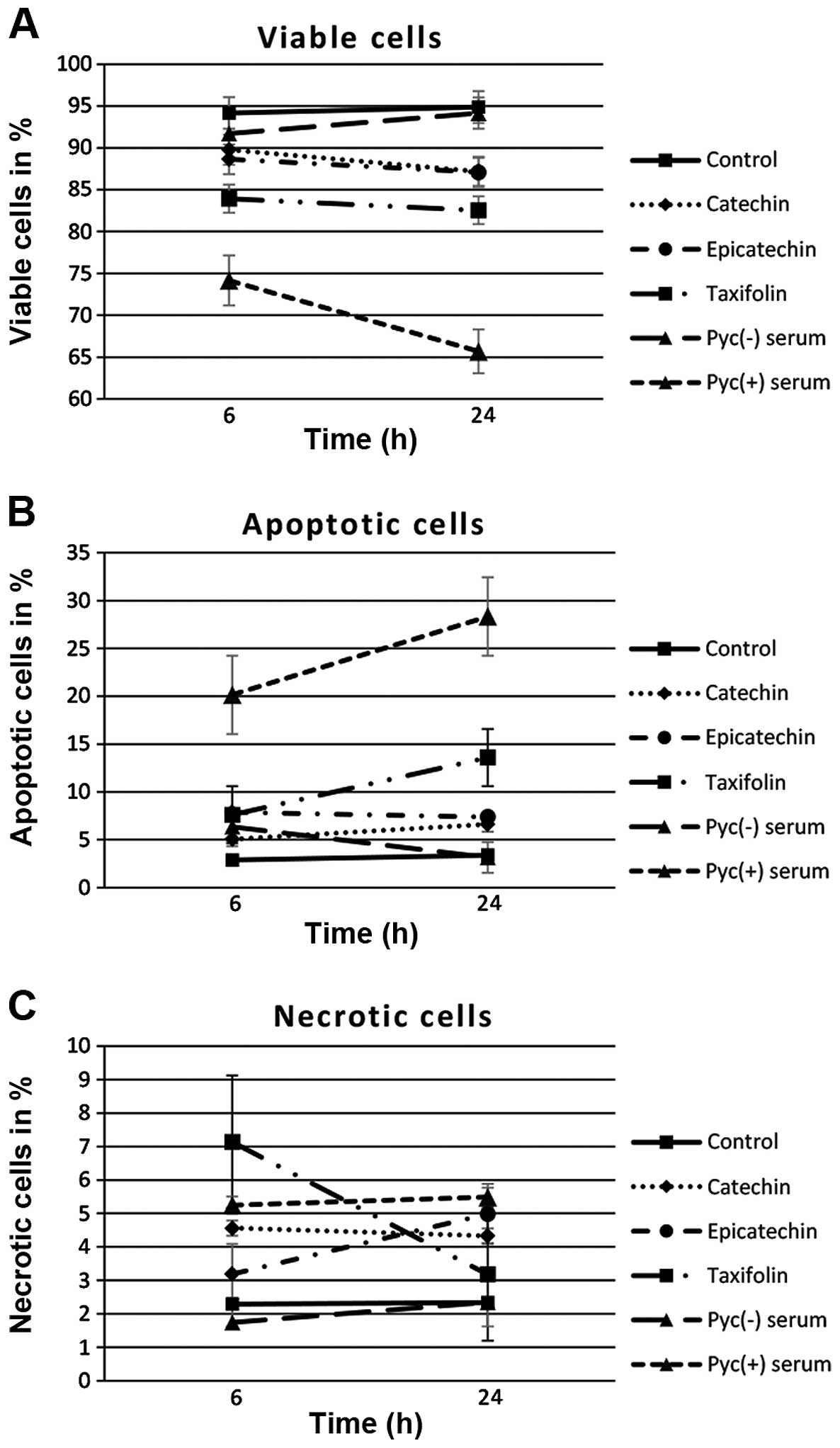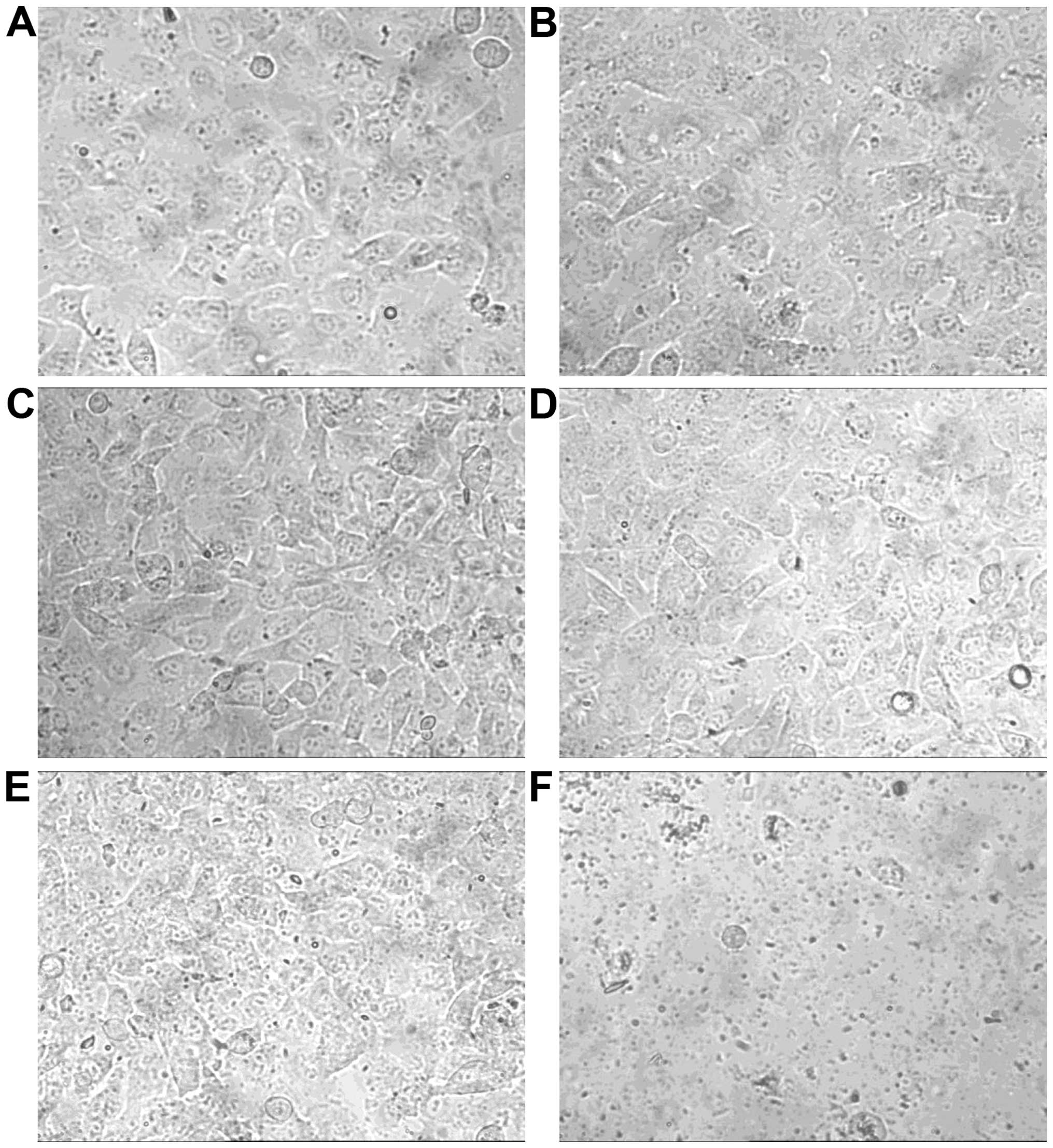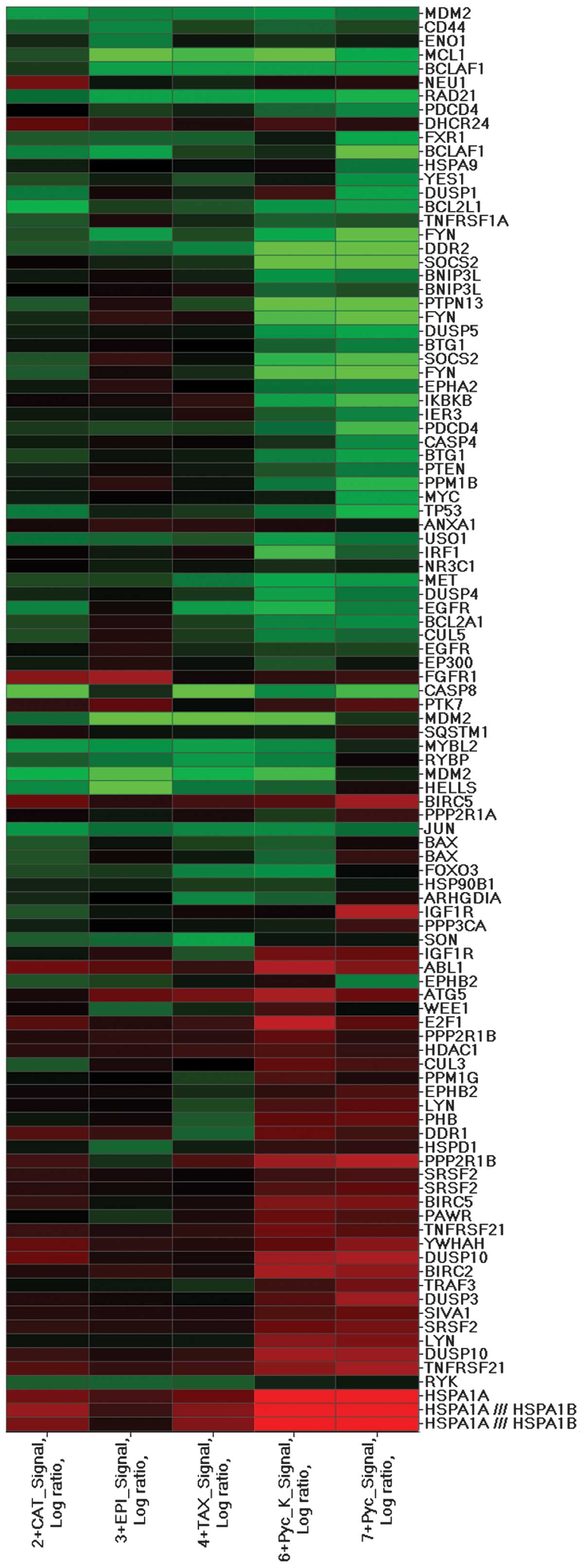|
1
|
Hoos A, Lewis JJ and Brennan MF: Soft
tissue sarcoma: prognostic factors and multimodal treatment.
Chirurg. 71:787–794. 2000.(In German). View Article : Google Scholar : PubMed/NCBI
|
|
2
|
Patrikidou A, Domont J, Cioffi A and Le
Cesne A: Treating soft tissue sarcomas with adjuvant chemotherapy.
Curr Treat Options Oncol. 12:21–31. 2011. View Article : Google Scholar : PubMed/NCBI
|
|
3
|
Kaushal A and Citrin D: The role of
radiation therapy in the management of sarcomas. Surg Clin North
Am. 88:629–646. 2008. View Article : Google Scholar : PubMed/NCBI
|
|
4
|
O’Brien GC, Cahill RA, Bouchier-Hayes DJ
and Redmond HP: Co-immunotherapy with interleukin-2 and taurolidine
for progressive metastatic melanoma. Ir J Med Sci. 175:10–14. 2006.
View Article : Google Scholar
|
|
5
|
Solomon LR, Cheesbrough JS, Bhargava R, et
al: Observational study of need for thrombolytic therapy and
incidence of bacteremia using taurolidine-citrate-heparin,
taurolidine-citrate and heparin catheter locks in patients treated
with hemodialysis. Semin Dial. 25:233–238. 2012. View Article : Google Scholar
|
|
6
|
Karavasilis V, Seddon BM, Ashley S,
Al-Muderis O, Fisher C and Judson I: Significant clinical benefit
of first-line palliative chemotherapy in advanced soft-tissue
sarcoma: retrospective analysis and identification of prognostic
factors in 488 patients. Cancer. 112:1585–1591. 2008. View Article : Google Scholar : PubMed/NCBI
|
|
7
|
Billingsley KG, Lewis JJ, Leung DH, Casper
ES, Woodruff JM and Brennan MF: Multifactorial analysis of the
survival of patients with distant metastasis arising from primary
extremity sarcoma. Cancer. 85:389–395. 1999. View Article : Google Scholar : PubMed/NCBI
|
|
8
|
Pezzi CM, Pollock RE, Evans HL, et al:
Preoperative chemotherapy for soft-tissue sarcomas of the
extremities. Ann Surg. 211:476–481. 1990. View Article : Google Scholar : PubMed/NCBI
|
|
9
|
Donato Di Paola E and Nielsen OS; EORTC
Soft Tissue and Bone Sarcoma Group. The EORTC soft tissue and bone
sarcoma group. European Organisation for Research and Treatment of
Cancer. Eur J Cancer. 38(Suppl 4): S138–S141. 2002. View Article : Google Scholar : PubMed/NCBI
|
|
10
|
Nedea EA and DeLaney TF: Sarcoma and skin
radiation oncology. Hematol Oncol Clin North Am. 20:401–429. 2006.
View Article : Google Scholar : PubMed/NCBI
|
|
11
|
Brodowicz T, Schwameis E, Widder J, et al:
Intensified adjuvant IFADIC chemotherapy for adult soft tissue
sarcoma: a prospective randomized feasibility trial. Sarcoma.
4:151–160. 2000. View Article : Google Scholar
|
|
12
|
Frustaci S, Gherlinzoni F, De Paoli A, et
al: Adjuvant chemotherapy for adult soft tissue sarcomas of the
extremities and girdles: results of the Italian randomized
cooperative trial. J Clin Oncol. 19:1238–1247. 2001.PubMed/NCBI
|
|
13
|
Judson I, Verweij J, Gelderblom H, et al:
Doxorubicin alone versus intensified doxorubicin plus ifosfamide
for first-line treatment of advanced or metastatic soft-tissue
sarcoma: a randomised controlled phase 3 trial. Lancet Oncol.
15:415–423. 2014. View Article : Google Scholar : PubMed/NCBI
|
|
14
|
Swain SM, Whaley FS and Ewer MS:
Congestive heart failure in patients treated with doxorubicin: a
retrospective analysis of three trials. Cancer. 97:2869–2879. 2003.
View Article : Google Scholar : PubMed/NCBI
|
|
15
|
Burningham Z, Hashibe M, Spector L and
Schiffman JD: The epidemiology of sarcoma. Clin Sarcoma Res.
2:142012. View Article : Google Scholar : PubMed/NCBI
|
|
16
|
Grimm T, Skrabala R, Chovanová Z, et al:
Single and multiple dose pharmacokinetics of maritime pine bark
extract (pycnogenol) after oral administration to healthy
volunteers. BMC Clin Pharmacol. 6:42006. View Article : Google Scholar : PubMed/NCBI
|
|
17
|
Rohdewald P: A review of the French
maritime pine bark extract (Pycnogenol), a herbal medication with a
diverse clinical pharmacology. Int J Clin Pharmacol Ther.
40:158–168. 2002. View
Article : Google Scholar : PubMed/NCBI
|
|
18
|
Packer L, Rimbach G and Virgili F:
Antioxidant activity and biologic properties of a procyanidin-rich
extract from pine (Pinus maritima) bark, pycnogenol. Free Radic
Biol Med. 27:704–724. 1999. View Article : Google Scholar : PubMed/NCBI
|
|
19
|
Huang WW, Yang JS, Lin CF, Ho WJ and Lee
MR: Pycnogenol induces differentiation and apoptosis in human
promyeloid leukemia HL-60 cells. Leuk Res. 29:685–692. 2005.
View Article : Google Scholar : PubMed/NCBI
|
|
20
|
Buz’Zard AR and Lau BH: Pycnogenol reduces
talc-induced neoplastic transformation in human ovarian cell
cultures. Phytother Res. 21:579–586. 2007. View Article : Google Scholar
|
|
21
|
Huynh HT and Teel RW: Selective induction
of apoptosis in human mammary cancer cells (MCF-7) by pycnogenol.
Anticancer Res. 20:2417–2420. 2000.PubMed/NCBI
|
|
22
|
Belcaro G, Cesarone MR, Genovesi D, et al:
Pycnogenol may alleviate adverse effects in oncologic treatment.
Panminerva Med. 50:227–234. 2008.PubMed/NCBI
|
|
23
|
Chow HH, Hakim IA, Vining DR, et al:
Effects of dosing condition on the oral bioavailability of green
tea catechins after single-dose administration of Polyphenon E in
healthy individuals. Clin Cancer Res. 11:4627–4633. 2005.
View Article : Google Scholar : PubMed/NCBI
|
|
24
|
Daigeler A, Brenzel C, Bulut D, et al:
TRAIL and Taurolidine induce apoptosis and decrease proliferation
in human fibro-sarcoma. J Exp Clin Cancer Res. 27:822008.
View Article : Google Scholar
|
|
25
|
Backes C, Keller A, Kuentzer J, et al:
GeneTrail - advanced gene set enrichment analysis. Nucleic Acids
Res. 35:W186–W192. 2007. View Article : Google Scholar : PubMed/NCBI
|
|
26
|
Feng WH, Wei HL and Liu GT: Effect of
PYCNOGENOL on the toxicity of heart, bone marrow and immune organs
as induced by antitumor drugs. Phytomedicine. 9:414–418. 2002.
View Article : Google Scholar : PubMed/NCBI
|
|
27
|
Abd El-Aziz TA, Mohamed RH, Pasha HF and
Abdel-Aziz HR: Catechin protects against oxidative stress and
inflammatory- mediated cardiotoxicity in adriamycin-treated rats.
Clin Exp Med. 12:233–240. 2012. View Article : Google Scholar
|
|
28
|
Du Y and Lou H: Catechin and
proanthocyanidin B4 from grape seeds prevent doxorubicin-induced
toxicity in cardiomyocytes. Eur J Pharmacol. 591:96–101. 2008.
View Article : Google Scholar : PubMed/NCBI
|
|
29
|
Raynaud FI, Eccles S, Clarke PA, et al:
Pharmacologic characterization of a potent inhibitor of class I
phosphatidylinositide 3-kinases. Cancer Res. 67:5840–5850. 2007.
View Article : Google Scholar : PubMed/NCBI
|
|
30
|
Willems L, Tamburini J, Chapuis N, Lacombe
C, Mayeux P and Bouscary D: PI3K and mTOR signaling pathways in
cancer: new data on targeted therapies. Curr Oncol Rep. 14:129–138.
2012. View Article : Google Scholar : PubMed/NCBI
|
|
31
|
Guo S, Lopez-Marquez H, Fan KC, et al:
Synergistic effects of targeted PI3K signaling inhibition and
chemotherapy in liposarcoma. PLoS One. 9:e939962014. View Article : Google Scholar : PubMed/NCBI
|
|
32
|
Hernando E, Charytonowicz E, Dudas ME, et
al: The AKT-mTOR pathway plays a critical role in the development
of leiomyo-sarcomas. Nat Med. 13:748–753. 2007. View Article : Google Scholar : PubMed/NCBI
|
|
33
|
Cheung M and Testa JR: Diverse mechanisms
of AKT pathway activation in human malignancy. Curr Cancer Drug
Targets. 13:234–244. 2013. View Article : Google Scholar : PubMed/NCBI
|
|
34
|
Ito S, Koshikawa N, Mochizuki S and
Takenaga K: 3-Methy-ladenine suppresses cell migration and invasion
of HT1080 fibrosarcoma cells through inhibiting phosphoinositide
3-kinases independently of autophagy inhibition. Int J Oncol.
31:261–268. 2007.PubMed/NCBI
|
|
35
|
Weinspach D, Seubert B, Schaten S, et al:
Role of L1 cell adhesion molecule (L1CAM) in the metastatic
cascade: promotion of dissemination, colonization, and metastatic
growth. Clin Exp Metastasis. 31:87–100. 2014. View Article : Google Scholar
|
|
36
|
Nikitovic D, Berdiaki A, Banos A,
Tsatsakis A, Karamanos NK and Tzanakakis GN: Could growth
factor-mediated extracellular matrix deposition and degradation
offer the ground for directed pharmacological targeting in
fibrosarcoma? Curr Med Chem. 20:2868–2880. 2013. View Article : Google Scholar : PubMed/NCBI
|
|
37
|
Gong M, Ueda Y, Kanazawa Y, Tsuchiya H and
Ma YG: Association of gene FN1 with pulmonary metastasis of human
fibrosarcoma. Zhonghua Zhong Liu Za Zhi. 29:14–16. 2007.(In
Chinese). PubMed/NCBI
|
|
38
|
Ying L, Lau A, Alvira CM, et al:
LC3-mediated fibronectin mRNA translation induces fibrosarcoma
growth by increasing connective tissue growth factor. J Cell Sci.
122:1441–1451. 2009. View Article : Google Scholar : PubMed/NCBI
|
|
39
|
Sato H, Hasegawa T, Kanai Y, et al:
Expression of cadherins and their undercoat proteins (alpha-,
beta-, and gamma-catenins and p120) and accumulation of
beta-catenin with no gene mutations in synovial sarcoma. Virchows
Arch. 438:23–30. 2001. View Article : Google Scholar : PubMed/NCBI
|
|
40
|
Nishikawa R, Goto Y, Kojima S, et al:
Tumor-suppressive microRNA-29s inhibit cancer cell migration and
invasion via targeting LAMC1 in prostate cancer. Int J Oncol.
45:401–410. 2014.PubMed/NCBI
|
|
41
|
Shouda T, Hiraoka K, Komiya S, et al:
Suppression of IL-6 production and proliferation by blocking STAT3
activation in malignant soft tissue tumor cells. Cancer Lett.
231:176–184. 2006. View Article : Google Scholar : PubMed/NCBI
|
|
42
|
Yan S, Li Z and Thiele CJ: Inhibition of
STAT3 with orally active JAK inhibitor, AZD1480, decreases tumor
growth in Neuroblastoma and Pediatric Sarcomas in vitro and in
vivo. Oncotarget. 4:433–445. 2013.PubMed/NCBI
|
|
43
|
Li N, Grivennikov SI and Karin M: The
unholy trinity: inflammation, cytokines, and STAT3 shape the cancer
microenvironment. Cancer Cell. 19:429–431. 2011. View Article : Google Scholar : PubMed/NCBI
|
|
44
|
Redell MS, Ruiz MJ, Alonzo TA, Gerbing RB
and Tweardy DJ: Stat3 signaling in acute myeloid leukemia:
ligand-dependent and -independent activation and induction of
apoptosis by a novel small-molecule Stat3 inhibitor. Blood.
117:5701–5709. 2011. View Article : Google Scholar : PubMed/NCBI
|
|
45
|
Senft C, Priester M, Polacin M, et al:
Inhibition of the JAK-2/STAT3 signaling pathway impedes the
migratory and invasive potential of human glioblastoma cells. J
Neurooncol. 101:393–403. 2011. View Article : Google Scholar
|
|
46
|
Teng Y, Xie X, Walker S, White DT, Mumm JS
and Cowell JK: Evaluating human cancer cell metastasis in
zebrafish. BMC Cancer. 13:4532013. View Article : Google Scholar : PubMed/NCBI
|
|
47
|
Miyamoto C, Maehata Y, Ozawa S, et al:
Fasudil suppresses fibrosarcoma growth by stimulating secretion of
the chemokine CXCL14/BRAK. J Pharmacol Sci. 120:241–249. 2012.
View Article : Google Scholar : PubMed/NCBI
|
|
48
|
Kosla J, Paňková D, Plachý J, et al:
Metastasis of aggressive amoeboid sarcoma cells is dependent on
Rho/ROCK/MLC signaling. Cell Commun Signal. 11:512013. View Article : Google Scholar : PubMed/NCBI
|
|
49
|
Wang XM, Li J, Yan MX, et al: Integrative
analyses identify osteopontin, LAMB3 and ITGB1 as critical
pro-metastatic genes for lung cancer. PLoS One. 8:e557142013.
View Article : Google Scholar : PubMed/NCBI
|
|
50
|
Song J, Zhang J, Wang J, et al: β1
integrin modulates tumor growth and apoptosis of human colorectal
cancer. Oncol Rep. 32:302–308. 2014.PubMed/NCBI
|
|
51
|
Wee S, Wiederschain D, Maira SM, et al:
PTEN-deficient cancers depend on PIK3CB. Proc Natl Acad Sci USA.
105:13057–13062. 2008. View Article : Google Scholar : PubMed/NCBI
|
|
52
|
Weber GL, Parat MO, Binder ZA, Gallia GL
and Riggins GJ: Abrogation of PIK3CA or PIK3R1 reduces
proliferation, migration, and invasion in glioblastoma multiforme
cells. Oncotarget. 2:833–849. 2011.PubMed/NCBI
|
|
53
|
Fu Y, Zhang Q, Kang C, et al: Inhibitory
effects of adenovirus mediated COX-2, Akt1 and PIK3R1 shRNA on the
growth of malignant tumor cells in vitro and in vivo. Int J Oncol.
35:583–591. 2009.PubMed/NCBI
|
|
54
|
Chin YR and Toker A: Function of Akt/PKB
signaling to cell motility, invasion and the tumor stroma in
cancer. Cell Signal. 21:470–476. 2009. View Article : Google Scholar :
|
|
55
|
Algarra I, Perez M, Serrano MJ, Garrido F
and Gaforio JJ: c-K-ras overexpression is characteristic for
metastases derived from a methylcholanthrene-induced fibrosarcoma.
Invasion Metastasis. 18:261–270. 1999. View Article : Google Scholar
|
|
56
|
Calvisi DF, Pinna F, Meloni F, et al:
Dual-specificity phosphatase 1 ubiquitination in extracellular
signal-regulated kinase-mediated control of growth in human
hepatocellular carcinoma. Cancer Res. 68:4192–4200. 2008.
View Article : Google Scholar : PubMed/NCBI
|
|
57
|
Gil-Araujo B, Toledo Lobo MV,
Gutiérrez-Salmerón M, et al: Dual specificity phosphatase 1
expression inversely correlates with NF-κB activity and expression
in prostate cancer and promotes apoptosis through a p38 MAPK
dependent mechanism. Mol Oncol. 8:27–38. 2014. View Article : Google Scholar
|
|
58
|
Yoshitomi T, Kawakami K, Enokida H, et al:
Restoration of miR-517a expression induces cell apoptosis in
bladder cancer cell lines. Oncol Rep. 25:1661–1668. 2011.PubMed/NCBI
|
|
59
|
Payne CM, Holubec H, Bernstein C, et al:
Crypt-restricted loss and decreased protein expression of
cytochrome C oxidase subunit I as potential hypothesis-driven
biomarkers of colon cancer risk. Cancer Epidemiol Biomarkers Prev.
14:2066–2075. 2005. View Article : Google Scholar : PubMed/NCBI
|
|
60
|
Koyama T, Mikami T, Koyama T, et al:
Apoptosis induced by chemotherapeutic agents involves c-Jun
N-terminal kinase activation in sarcoma cell lines. J Orthop Res.
24:1153–1162. 2006. View Article : Google Scholar : PubMed/NCBI
|












